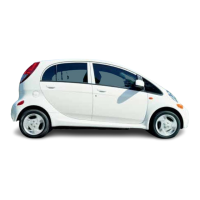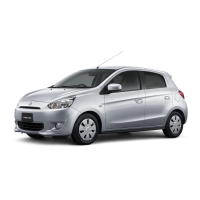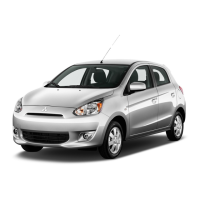lo-18
Chapter 10 Suspension and steering systems
18.10
Steering linkage components -exploded view
idler arm bracket
Idler arm bushing
Idler arm
Heat shield
Dust cover
O-ring
Right side tie-rod assembly
Relay rod
Left side tie-rod assembly
18.11 Use a puller to separate the tie-rod end from the
steering knuckle
\
1 All steering linkage removal and installation procedures should be
performed with-the front end of the vehicle raised and placed securely on
jackstands.
2
Before removing any steering linkage components, obtain a balljoint
separator. It may be a screw-type puller or a wedge-type (pickle fork) tool,
although the wedge-type tool tends to damage the balljoint seals. It is pos-
sible to jar a balljoint taper pin free from its eye by striking opposite sides of
the eye simultaneously with two large hammers, but the space available to
do so is usually very limited.
3 After installing any of the steering linkage components, the front
wheel alignment should be checked by a reputable front end alignment
shop.
Pif/m?n arm
4
Remove the nut securing the Pitman arm to the steering gear sector
shaft.
5 Scribe or paint match marks on the arm and shaft.
6 Using a puller, disconnect the Pitman arm from the shaft splines.
7 Remove the cotter pin and castle nut securing the Pitman arm to the
relay rod.
8 Using a puller, disconnect the Pitman arm from the relay rod.
9 Installation is the reverse of the removal procedure. Be sure to tighten
the nuts to the torques Ifsted in this Chapter’s Specifications and install a’
new cotter pin.
Tie-rod
Refer to illustrations 18.10 and 18.1 I
10 Remove the cotter pins and castle nuts securing the tie-rod to the
relay rod and knuckle arm (see illustration).
11 Separate the tie-rod from the relay rod and knuckle arm with a puller
(see illustration).
12 If a tie-rod end is to be replaced, loosen the jam nut and mark the rela-
tionship of the tie-rod end to the tie-rod with white paint. When installing
the new rod end, thread it onto the tie-rod until it reaches the mark, then
turn the jam nut until it contacts the rod end. Don’t tighten it fully at this time.
13 Turn the tie-rod ends so they are at approximately go-degree angles
to each other, then tighten the jam nuts to lock the ends in position.
14 The remaining installation steps are the reverse of those for removal.
Make sure to tighten the castle nuts to the torques listed in this Chapter’s
Specifications.
Idler arm
15 Remove the nut securing the idler arm to the bracket (see illustration
18.10).
16 Remove the cotter pin and castle nut securing the idler arm to the
relay rod.
17 Using a puller, disconnect the idler arm from the relay rod.
18 Slide the idler arm off the bracket shaft and remove it from the vehicle.
19 Installation is the reverse of the removal procedure. Be sure to tighten
the nuts to the specified torque and install a new cotter pin.
19 Steering gear - removal and installation
Warning: Wheneveranyofthesuspensionorsteering fastenersareloos-
enedor
removed they must be inspectedand, if necessary, replaced with
newonesofthesamepartnumberoroforiginalequipmentqualityandde-
sign. Torque specifications must be followed for proper reassembly and
component retention.
\
Note: lfyou find that the steeringgearis defective, it is not recommended
that you overhaul it. Because of the special tools needed to do the job, it is
best to let your dealer service department overhaul it for you (or replace %-
with a factory rebuilt unit). However, you can remove andinstallit yourself
by following theprocedureoutlinedhere. Theremovalandinstaltionpro-
cedures for manual steering andpower steering gear housings are identi-
calexcept that theinletandoutlettines mustberemovedfrom thesteering

